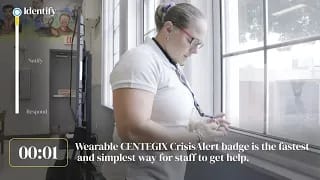Empower Your Educators with School Safety Solutions for Rapid Incident Response.
School emergencies happen, and when they do, EVERY. SECOND. MATTERS. ® Give your educators peace of mind about their safety so they can focus on what matters most—creating prosperous learning environments.
Protect Your Campuses. Empower Your Educators with School Safety Solutions for Rapid Incident Response.
Emergencies happen, and when they do, EVERY. SECOND. MATTERS. ® Give your educators peace of mind about their safety so they can focus on what matters most—creating prosperous learning environments.

Your Safety Partner When EVERY. SECOND. MATTERS. ®
We know that becoming an educator is a calling. But everyday diversions—medical emergencies, student altercations, unauthorized visitors, suspicious activity—limit learning and test the passion of your teachers. They’re looking to leaders like you to protect the learning environment, and that’s a responsibility no one should bear alone.
Schools across the nation rely on us to protect those in their care. The CENTEGIX Safety Platform™ is the foundation of your layered safety plan, empowering the fastest response to emergencies. Because EVERY. SECOND. MATTERS. ®

Discover the School Safety Solutions of the CENTEGIX Safety Platform™
Discover the School Safety Solutions of the CENTEGIX Safety Platform™


CENTEGIX CrisisAlert™ for Schools
CrisisAlert Is in a Class of Its Own
We don’t just raise the bar. We built it.
We lead the nation in wearable panic button technology—for good reason. CrisisAlert is the most widely adopted solution of its kind, proven in hundreds of thousands of real-life emergencies. No other solution offers the same depth, reliability, or reach.
Unlike other wearable panic buttons, CrisisAlert activates a fully integrated emergency response and notification system, including flashing strobes, intercom announcements, and computer screen takeovers. It’s the only solution with 100% campus-wide coverage that immediately sends a digital map to first responders with precise location details, down to the exact floor and room, detailing every safety asset in proximity of the alert, to protect your staff wherever they are.
As the most trusted and deployed solution on the market, CrisisAlert goes beyond the badge, delivering unrivaled reliability, redundancy, notification, and response capabilities.
CENTEGIX CrisisAlert™ for Education

CENTEGIX Wearable School Panic Buttons are Years Ahead and Built from Experience
Others are trying to catch up, but imitation can’t replace experience. The new wearable badges may look similar, but they’re brand new, untested, and—by all indications—not operational in schools. Check out our wearable panic button comparison chart to learn why experience matters.
CENTEGIX Wearable School Panic Buttons are Years Ahead and Built from Experience
Others are trying to catch up, but imitation can’t replace experience. The new wearable badges may look similar, but they’re brand new, untested, and—by all indications—not operational in schools. Check out our wearable panic button comparison chart to learn why experience matters.
CENTEGIX Safety BlueprintTM for Schools

Your Safety Partner When EVERY. SECOND. MATTERS. ®
We know that becoming an educator is a calling. But everyday diversions—medical emergencies, student altercations, unauthorized visitors, suspicious activity—limit learning and test the passion of your teachers and educators. They’re looking to leaders like you to protect the learning environment, and that’s a responsibility no one should bear alone.
Schools across the nation rely on us to protect those in their care. The CENTEGIX Safety Platform™ is the foundation of your layered safety plan, empowering the fastest response to emergencies. Because EVERY. SECOND. MATTERS. ®

In an Emergency, You Need CrisisAlert
See how our CrisisAlert wearable mobile panic button empowers staff to get help instantly in an emergency.
Safety Front and Center with CrisisAlert
Total campus coverage
Our private, managed network secures every square foot of your campus—the CrisisAlert badge functions everywhere. So no matter where you are from the classroom to the baseball diamond—your call for help instantly reaches responders. No Wi-Fi or cell signal is needed.
Location accuracy
Our innovative technology provides specific location details, down to an individual floor and room,
so first responders know exactly where their help is needed.
One-button activation
The CrisisAlert wearable badge has a single button, enabling discreet, quick human action in emergencies. Simply push the button and help is on the way.
Immediate notification
With a push of a button, the safety alert instantly reaches administrators and responders, displaying a map of who needs help and where they are located. No delay, no valuable seconds lost.
Audio and visual notification
Campus-wide alerts communicate emergency information using colored strobe lights, desktop alerts, and intercom and mass communication integrations so everyone can get to safety as soon as possible.
Alert management
CrisisAlert Responder Application allows administrators to quickly manage and monitor an emergency event as it’s unfolding, providing alert notification and activation functionality, along with full crisis management capability.
Alyssa's Law and Act
CrisisAlert meets Alyssa’s Law mandates for silent mobile panic button systems that are directly linked to law enforcement. CrisisAlert meets the new Alyssa’s Act which will require public schools across America to provide all classrooms with silent panic alert technology.
100% adoption
The CrisisAlert wearable badge alleviates concerns often raised about app-based safety solutions. There’s no request to download technology onto a personal cell phone and no need to keep an app up-to-date. All staff have a badge, ensuring 100% user adoption.
School Safety Trends Report
Staff, students, or admin—those in education face major challenges. In our report, we offer our latest, comprehensive analysis of school safety incidents and staff survey feedback gathered from our CrisisAlert and Visitor Management usage data for the 2023/2024 school year. Read about the trends shaping safety and security across the nation.

School Safety Trends Report
Staff, students, or admin—those in education face major challenges. In our report, we offer our latest, comprehensive analysis of school safety incidents and staff survey feedback gathered from our CrisisAlert and Visitor Management usage data for the 2023/2024 school year. Read about the trends shaping safety and security across the nation.

School Improvement from a Culture of Safety
When your educators feel safe, they’re empowered to focus on their calling: educating the minds of tomorrow by creating a productive learning environment.
Improve Staff Retention and Recruitment
We looked at reasons teachers stay in the profession as well as those drivers that make them decide to leave, and it wasn’t all about teacher pay.
The eye-opener for us was the ability to address teachers’ mental and emotional health as well as teachers’ safety. We wanted to respond to that in a way that really honored their voices and gave them an opportunity to see that we’re listening and will do something.
In their collective bargaining agreement, teachers included an additional article that talks about safety from the standpoint of employees being able to intervene in an appropriate manner and receive assistance when safety issues arise. When we listen to our teachers and respond, we’re able to retain our teachers. We saw over the past two years that we had 25-30 teachers return who had left the district. They came back because they heard the district was really honoring and listening to their voices. They had left, and they came back, and that was unheard of for us.
Provide Actionable Data
Administrators know that better data leads to more effective solutions. From measuring student progress to evaluating curriculum effectiveness to tracking absences or the allocation of resources, the more metrics, the better. With numbers in hand, change is possible.
When administrators are evaluating their schools, they can ask:
- Is there adequate support in each classroom?
- Are there areas within the school that have a higher incidence of student misconduct?
- Are there teachers who need additional professional learning?
- Are there changes that need to happen in certain classrooms?
Useful data collected over time may reveal that a significant change is needed, like assigning seats or separating specific students who don’t get along. With CrisisAlert in place to collect incident data, the situation becomes clearer and the school can directly address and correct the issues.
Reclaim Lost Instructional Time
In our schools, just about everybody in the building had walkie-talkies, so constantly, teachers were on them. And students were hearing this. They may have been focused on an assignment, but then they were hearing, ‘I need help in room 108,’ and now everyone is wondering, what’s happening 108?
That was one of the reasons we partnered with CENTEGIX: to be responsive to our teachers, ensure they had ways to get someone to their classroom without disruption where they could protect the learning and teaching process for everyone else.
Interruptions during the school day eat away at instructional time in the classroom. From classroom behavioral incidents to minor medical emergencies, disruptions affect the learning process for everyone present. While interruptions are inevitable, teachers can address and resolve disruptions to regain classroom focus as quickly as possible.
Teacher Tested
We engage with teachers and staff every day to understand how CrisisAlert supports them, and here’s what they’ve shared:
99%
said ‘Yes’
98%
said ‘Yes’
96%
said ‘Yes’
92%
said ‘Yes’
Teacher Tested
We engage with teachers and staff every day to understand how CrisisAlert supports them, and here’s what they’ve shared:
99%
said ‘Yes’
98%
said ‘Yes’
96%
said ‘Yes’
92%
said ‘Yes’
Life-Saving Technology with a Push of a Button
CENTEGIX Safety BlueprintTM for Schools

CENTEGIX Visitor Management for Schools
Never question who’s on your campus again. Our school visitor management system checks in and screens all visitors before they enter your school, and can locate them during their stay. Plus much more.
School visitor screening
Screen visitors against the national sexual offender database and your custom background checklist, and monitor custody issues automatically.
Student attendance reporting
Simplify your tardy student and early dismissal process by quickly signing in late students from your desk, printing hall passes, recording early dismal, and performing custody issue and sex offender background checks before release.
Instant notification alerts
Respond quickly to school check-ins and emergencies that need reviewing by alerting staff in real time.
Record staff and volunteer activities
Log teacher, substitute, staff, and volunteer hours, provide daily wellness screening questionnaires to staff and volunteers, and record activities from anywhere—on campus and remotely.
Integration partnerships save time and money
Sync student attendance directly with your student information system through our PowerSchool and OneRoster integrations. Sync volunteer applications with our Sterling Volunteers integration.

CENTEGIX Reunification for Schools
Accountability with a real-time, digital roster of students
Quickly scan a student’s ID or look up their name to mark them safe. Document the check-in time, name, and any other required information to update real-time reports.
Safe matching of parents, guardians, and students
Scan the student ID upon exiting the holding area to document the release time. Once reunited with their guardian, scan the QR code from the reunification slip to document exit time and successful completion. When adults arrive to reunite with their children, scan the parent or guardian ID, select the student name, and request their photo, signature, and other required information.
Digital slips for safe reunification
Once staff inputs all information, our reunification solution prints slips to keep reunification in order and efficient.
CENTEGIX Reunification for schools

Accountability with a real-time, digital roster of students
Quickly scan a student’s ID or look up their name to mark them safe. Document the check-in time, name, and any other required information to update real-time reports.
Safe matching of parents, guardians, and students
Scan the student ID upon exiting the holding area to document the release time. Once reunited with their guardian, scan the QR code from the reunification slip to document exit time and successful completion. When adults arrive to reunite with their children, scan the parent or guardian ID, select the student name, and request their photo, signature, and other required information.
Digital slips for safe reunification
Once staff inputs all information, our reunification solution prints slips to keep reunification in order and efficient.
Improve Your School’s Climate with a Culture of Safety
When your educators feel safe, they’re empowered to focus on their calling: educating the minds of tomorrow by creating a productive learning environment.
Instill confidence: Teachers and staff can get help with the push of a button.
Extend trust: Anywhere, anytime, teachers know support is available when EVERY. SECOND. MATTERS. ®
Offer peace of mind: Safety solutions ease concerns about how to act and respond in an emergency.
Recognized as the Nationwide Leader in Wearable Safety Technology and Campus Safety
700K+
CrisisAlert badge users
675K+
alerts delivered
15K+
locations covered


School District Leaders Help Shape Our School Safety Solutions

Empower Your Educators
with Safety
Your Questions, Answered
What’s the difference between CrisisAlert and other wearable panic buttons?
Backed by years of experience, proven in hundreds of thousands of real emergencies, and trusted by more schools than any other provider, CrisisAlert activates a fully integrated emergency response system—including flashing strobes, intercom announcements, and screen takeovers—to immediately alert the entire campus and notify first responders. CrisisAlert delivers over 20 critical features that set it apart. Discover why no other wearable compares.
Why is a wearable mobile panic button preferred over an app-based solution?
How does school safety boost enrollment?
Can I experience how the CrisisAlert badge works for myself?
Is there supplemental funding to help cover the costs of CENTEGIX for my school district?
Explore More Safety Resources
Supporting the Unique Safety Needs of Special Education Students and Staff
In our case study, learn how Meade County School District has supported and empowered their special education staff and students with the CENTEGIX Safety Platform™.
Visitor Management: Best Practices for Your School Safety Plan
CENTEGIX empowers thousands of schools to take control of their visitor management and protect their teachers, students, and staff. Get a copy of our Visitor Management Best Practices Guide today.
2024 School Safety Trends Report
This report offers our latest, comprehensive analysis of school safety incidents gathered from the CENTEGIX Safety Platform™ usage data for the 2023-2024 school year.
School Safety Standards by State
Schools in any state can meet school safety grant funding requirements by choosing the CENTEGIX Safety Platform™. Learn more about school safety in your state.

Board Chair POV: CENTEGIX is the Best Choice for Student Safety
Former DeKalb County Board Chair endorses the CENTEGIX Safety Platform as the best choice for creating safe schools.

CENTEGIX Launches Completely Reimagined Visitor Management Solution
CENTEGIX®, the industry leader in wearable safety technology, recently unveiled its reimagined Visitor Management Solution during a webinar on June 18. Built from the ground up, this new solution delivers faster and more flexible tools to streamline visitor check-ins, enhance security, and simplify operations for schools and facilities.

How to Prepare for Alyssa’s Law in Oklahoma: HB 4073
Oklahoma districts create safe schools and meet HB 4073 requirements by implementing the CENTEGIX Safety Platform.

The Silent Crisis: How Underreporting Undermines Safety in Healthcare
Nurses and clinicians frequently experience threats, aggression, and physical assaults—yet many remain silent. Why?
SOLUTIONS
INDUSTRIES
RESOURCES
COMPANY
PARTNERS
CONTACT
EVERY. SECOND. MATTERS.®












